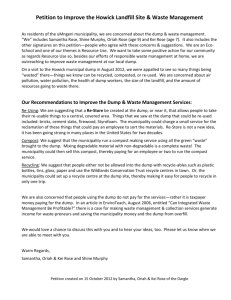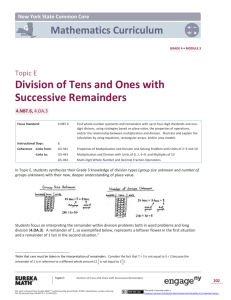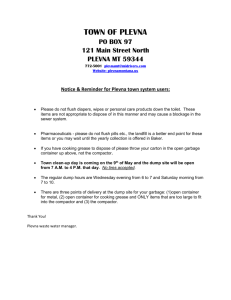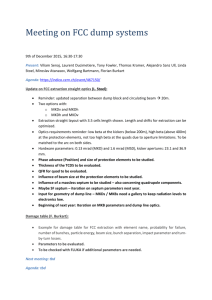(projdoc).
advertisement
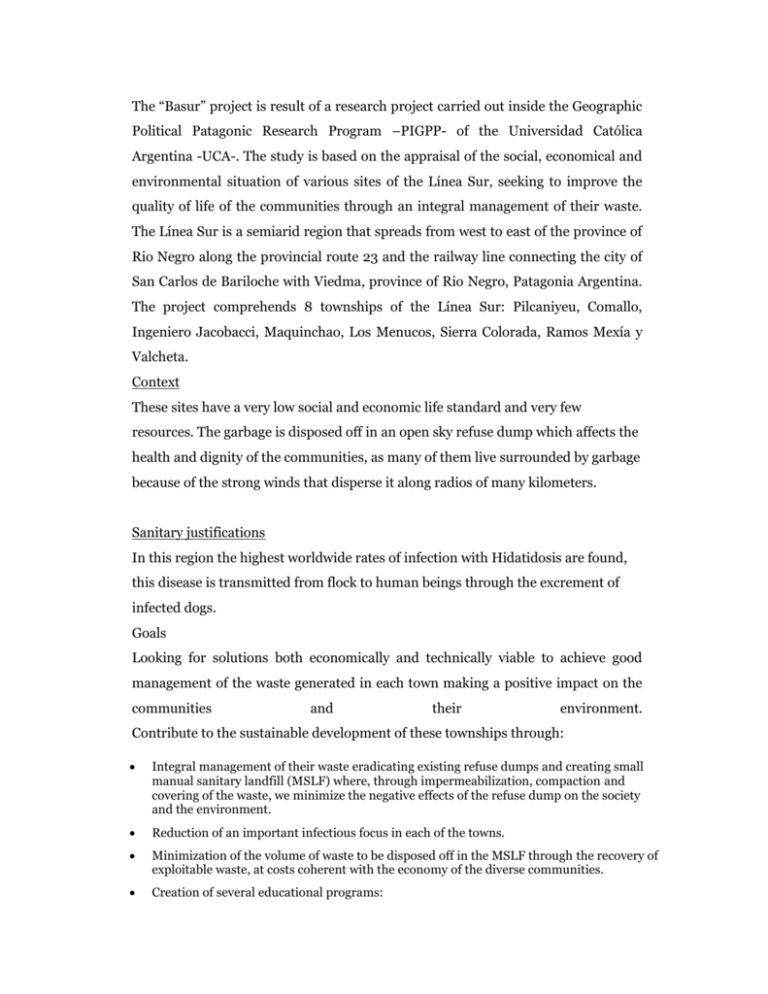
The “Basur” project is result of a research project carried out inside the Geographic Political Patagonic Research Program –PIGPP- of the Universidad Católica Argentina -UCA-. The study is based on the appraisal of the social, economical and environmental situation of various sites of the Línea Sur, seeking to improve the quality of life of the communities through an integral management of their waste. The Línea Sur is a semiarid region that spreads from west to east of the province of Rio Negro along the provincial route 23 and the railway line connecting the city of San Carlos de Bariloche with Viedma, province of Rio Negro, Patagonia Argentina. The project comprehends 8 townships of the Línea Sur: Pilcaniyeu, Comallo, Ingeniero Jacobacci, Maquinchao, Los Menucos, Sierra Colorada, Ramos Mexía y Valcheta. Context These sites have a very low social and economic life standard and very few resources. The garbage is disposed off in an open sky refuse dump which affects the health and dignity of the communities, as many of them live surrounded by garbage because of the strong winds that disperse it along radios of many kilometers. Sanitary justifications In this region the highest worldwide rates of infection with Hidatidosis are found, this disease is transmitted from flock to human beings through the excrement of infected dogs. Goals Looking for solutions both economically and technically viable to achieve good management of the waste generated in each town making a positive impact on the communities and their environment. Contribute to the sustainable development of these townships through: Integral management of their waste eradicating existing refuse dumps and creating small manual sanitary landfill (MSLF) where, through impermeabilization, compaction and covering of the waste, we minimize the negative effects of the refuse dump on the society and the environment. Reduction of an important infectious focus in each of the towns. Minimization of the volume of waste to be disposed off in the MSLF through the recovery of exploitable waste, at costs coherent with the economy of the diverse communities. Creation of several educational programs: 1. At the community level, on the methodology of waste separation (compostable organic material, glass, PET and rejection) 2. At primary and secondary educational level, on the methodology of composting and the creation of vegetable gardens and plant nurseries. 3. At the technical level for ecologic operators that have to manage the MSLF. Creation of new jobs in the areas of composting and recycling. Improvement of the quality of life of the inhabitants. Their integration to the environmental preservation process Project’s best practice methods in terms of vision, strategy and methodology for implementation and success. Vision: Improve the quality of life of the inhabitants of low resource townships exploring solutions both economically and technically viable through the comprehensive management of waste to reach economic development, social equity and environmental preservation, in search of sustaintability. Strategy: The project is divided en three stages to allow each township to progress in relation to it’s economic, human and cultural resources in the period of time each of them will require. In the first stage we seek to generate commitment of the community through a municipal initiative for the improvement of the integral management of waste, it’s final disposition and the closing of the present refuse dump. This municipal action will allow working with the community in the following stages of the project. In the second stage we will search to create a higher benefit for the population at a local level, by the separation of solid organic waste with the scope of making compost, which will benefit the fertilization of land and of the vegetable gardens or the plantations of local species for reforestation of the region. In the third stage we propose the separation and gathering at a regional level of recyclable materials such as PET and glass to which may be given different usages, like reutilization or sale. Methodology: Education will be the transformation strategy to reach the sustainable development of the Línea Sur. We will carry out a program to increase awareness in all the population, working with schools, hospitals and municipalities. The educational plan will be directed to: 1. All the community, on the methodology of waste separation (compostable organic material, glass, PET and rejection) 2. To teachers and students from primary and secondary schools on the methodology of composting and the creation of vegetable gardens and plant nurseries. 3. To ecologic operators that have to manage MSLF, providing technical training. Through this program we aim to transmit the importance of a correct comprehensive waste management and the need of the participation of the townfellows jointly with the local authorities to reach a better life standard. Implementation Duration: 1 year for the 1° stage, taking in consideration research, appraisal y construction of the MSLF; 8 months for stages 2° and 3°. Remarks: the stages of research, diagnosis and elaboration of reports have been completed, reaching an agreement with local authorities, but the program hasn’t been implemented yet due to the lack of funding. Use of ICTs in promoting the information society in the project. The ICT’S are of crucial importance in the educational and informative aspects of the project, because we plan to implement a training program, which will include educational presentations in digital format, providing a CD to those townships that don’t have internet access and through a web page for those who has access to the net and for all other people interested in the project. It’s important to point out that a project to provide Internet access in all the Línea Sur is in process of implementation. We will start implementing our project in Ing. Jacobacci, which already has Internet access. Addressing the beneficiarie’s developmental need using ICT in the project. It is done by allowing more people to acquire know-how on: composting, creation of vegetable gardens and plant nurseries, and increasing social awareness on the importance of better comprehensive management of waste. This would be achieved through the provision of a CD with educational presentations in digital format and through a web page, apart from printed material such as brochures and informative booklets, which will provide all necessary detailed technical information for the training of involved individuals and whoever is interested in the project. Also, every aspect of the project, it’s stages and parallel activities will be shown. Impact An improvement in the quality of life of the inhabitants, from better conditions of salubrity in the disposition of the sweepings since one of the infectious centers of the towns is diminished. To diminish the visual contamination generated by the rubbish dump to open sky Minimización of the volume of sweepings in the final disposition in the RSM through a better advantage of the remainders generating compost and recovering material reciclables. Generation of jobs in works of management of remainders. Generation of microemprendimientos at scholastic, secondary and communal level. Collaborating with the projects of production of orchards and communitarian breeding grounds. Awareness, education and qualification of the inhabitants of the line with respect to the treatment of remainders and advantage of such and promotion of a sustainable development at local and regional level. The creation of several educative programs at communitarian, scholastic and technical level. From the environmental thing one will work stops: To avoid the phreatic earth contamination and napas product of the leached ones generated by the remainders. At the moment, the rubbish dumps do not count on any waterproofing of the ground. To avoid the visual contamination generated by the remainders ready to open and exposed sky to strong winds characteristic of the zone. These remainders at the moment are dispersed in a radius of up to 12 km Short term will arrange the remainders in the controlled RSM where they will be covered dieriamente and. In the long term, when its life utility finalizes, the site will be closed and it will be possible to be transformed into a camouflaged green space with the surrounding landscape. To help to diminish the impact of the existing desertificación when fomenting the creation of breeding grounds for the forestación with native plants. To avoid the animal death product of the ingestion of remainders of the rubbish dump. The most affected they are ewes, goats, dogs and pigs by ingestion of polyethylene bags. To promote the recovery of remainders that would be arranged in the rubbish dump diminishing the buried volume. From the economic thing one will work stops: To generate jobs within the integral management of the remainders in each municipality. To promote the recovery of the remainders, that at the moment are rejected without being taken advantage of, through the commercialization, treatment, recycling or reusability. These three fields are related to each other, since when teaching to him to the inhabitant of each small municipality to take advantage of the remainders that it was eliminating, to remove economic benefit from such in the short term and working the Earth with compost that he himself I make '; also it gives back dignity to him when not being living as opposed to unhealthy conditions and avoids the environmental contamination generated by those remainders. Monitoring and Evaluation Methods Visits to the refuse dump: we observed the location of the present dump in relation to it’s distance from the town, the kind of land where it is located, the depth of the ground water in that place, the direction of the wind, the drainage of the water, the conditions of the surrounding environment and the impact on it. Characterization of the waste: In the municipalities in which we could accompany the waste collecting truck, we observed the course ending with the final disposal of the waste in the dump. In cases in which the waste collection had already been made, we worked directly with the waste collected the previous day and deposited in the dump. The studies were carried out over a sample of 150-200kg through cake method. Once the waste was separated for sampling, we calculated: <BR Density, using a bucket of known volume which was filled with waste without applying pressure and obtaining the density= mass/ volume. The procedure was repeated several times, averaging the results. It’s important to know the density of the waste to calculate the projected volume for the MSLF. Total volume PPC (production per capita in kg/inhab. day) Characterization of the waste separating them in: Organic matter o Glass o Fine plastic o Recyclable plastic o Textiles o Higenic o Paper and cardboard They were weighed separately to obtain the percentage in weight of each. This study is useful for future stages of the project, which are those of recycling. Sustainability The “Basur” project is a contribution to the sustainable development of the Línea Sur. The implementation of this project contemplates an improvement in the social, economic and environmental conditions that will have a positive impact in the life standard of the inhabitants of the Línea Sur obtaining short and long-term results. <BR In the social environment we will work through education as the way to create awareness and drive change. The inhabitants in general and the students from the schools will learn to: Manage better their waste, having a final disposal method, which does not affect their health, obtaining better conditions in the short-term. How to take advantage of the resources from the waste. We plan to take advantage of organic waste through the production of compost and of the recyclable waste like PET and glass. To take a better advantage of the land through the production of compost that way be used in vegetable gardens and plant nurseries. In the long-term this many become an important alternative for creating jobs. To make organic vegetable gardens that will allow diversifying the families’ basic diet. This would improve the health conditions of the population. This training will allow the development of entrepreneurship programs (vegetable gardens and plant nurseries), recovering the value of laboring the land with dignity and providing a more balanced diet covering the unsatisfied necessities of the present inhabitants. In the environmental aspect we will endeavor to: Avoid the pollution of the lands and ground water due to the leachate generated by the waste. At present, the dumps don’t have any impermeability treatment in the ground. Avoid the visual pollution generated by the waste distributed in open sky dumps and exposed to the strong winds, which are characteristic of the region. This waste is currently spread in an area of up to 12 km. In short-term the waste will be displayed in the MSLF where they will be covered and controlled daily. In long-term, when it’s useful life is finished, the place will be closed and transformed in a green space and camouflaged with the surrounding scenery. Help to minimize the impact of the existing desertification by encouraging the creation of plant nurseries for reforestation with native vegetation. Avoid the death of local fauna due to the ingestion of waste from the dump. The most affected are sheep, goats, dogs and pigs through the ingestion of polyethylene bags. Promote the recovery of waste that would otherwise be disposed off in the dump reducing the volume to be buried. In the economic aspect we will endeavor to: Create jobs in the comprehensive management of waste in each municipality. Promote the recovery of waste, that are currently disposed off without taking any advantage of them, through commercialization, treatment, recycling or reutilization. These three fields are deeply connected, because teaching the inhabitant of each small township to take advantage of the waste he is eliminating, to take economic advantage of them in short term and to labor the land with compost produced by himself; also returns him his dignity by preventing his living in insanitary conditions and avoiding environmental pollution caused by this waste.


